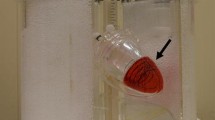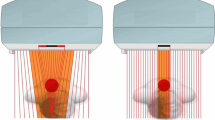Abstract.
Quantification of gated single-photon emission tomography (SPET) in small hearts has been considered to be inaccurate. To evaluate the validity of gated SPET in a small chamber volume, mathematical simulation and clinical application to paediatric patients were performed. Myocardium with various chamber sizes from 14 ml to 326 ml was generated assuming an arbitrary resolution (6.9–15.7 mm in full-width at half-maximum), noise and zooming factors. The cut-off frequency of the Butterworth filter for preprocessing was varied from 0.16 to 0.63 cycles/cm. The chamber volume was calculated by quantitative gated SPET software (QGS). The patients, aged 2 months to 19 years (n=27), were studied by gated technetium-99m methoxyisobutylisonitrile or tetrofosmin SPET. Image magnification as large as possible was performed during data acquisition to include the whole chest using 1.25–2.0 zooming. Based on the simulation study, an underestimation of the chamber volume occurred below a volume of 100 ml. The degree of underestimation for a 37-ml volume was 49% without zooming, but it improved to 3% with 2× zooming. Filters with a higher cut-off frequency, better system resolution and hardware zooming during acquisition improved quantitative accuracy in small hearts. For the subjects under 7 years old (n=7), quantification of volume and ejection fraction (EF) was possible in 72% of the patients. In those over 7 years old, gated SPET quantification was feasible in all cases. The correlation between gated SPET end-diastolic volume (SPET EDV) and both echocardiographic end-diastolic dimension (EDD) and echocardiographic EDV was good (r=0.84 between SPET EDV and echo EDD, r=0.85 between SPET EDV and echo EDV, P<0.0001 for both). The correlation between gated SPET EF and both echocardiographic fractional shortening (FS) and echocardiographic EF was fair (r=0.69 between SPET EF and echo FS, r=0.72 between SPET EF and echo EF, P<0.0001 for both). In conclusion, quantification of gated SPET of small hearts can be improved by means of a SPET filter with a high cut-off frequency, high system resolution and appropriate zooming. Gated SPET should be attempted not only in patients with small hearts but also in paediatric patients.
Similar content being viewed by others
Author information
Authors and Affiliations
Additional information
Received 20 January and in revised form 2 May 2000
Electronic Publication
An erratum to this article is available at http://dx.doi.org/10.1007/s002590000431.
Rights and permissions
About this article
Cite this article
Nakajima, K., Taki, J., Higuchi, T. et al. Gated SPET quantification of small hearts: mathematical simulation and clinical application. Eur J Nucl Med 27, 1372–1379 (2000). https://doi.org/10.1007/s002590000299
Published:
Issue Date:
DOI: https://doi.org/10.1007/s002590000299




